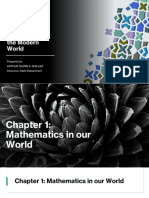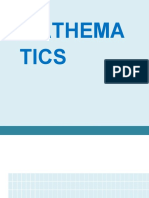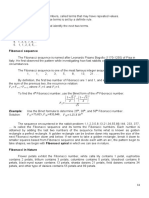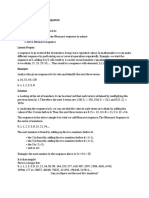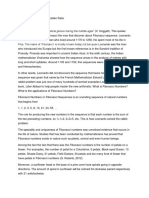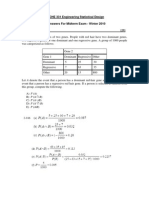Module in Fibonacci Sequence
Uploaded by
nbjeresano12Module in Fibonacci Sequence
Uploaded by
nbjeresano12The Fibonacci sequence
Topic: THE FIBONACCI SEQUENCE
Learning Objectives:
1.) Generate patterns by performing one or several mathematical operations repeatedly
2.) Appreciate the nature and uses of mathematics in everyday life
Lesson proper:
A sequence is an ordered list of numbers, called terms, that may have repeated values. The
arrangement of these terms is set by a definite rule.
Examples:
Analyze the given sequence for its rule and identify the next three terms
1.) 1, 10, 100, 1000
Solution:
Looking at a set of numbers, it can be observed that each term is a power of 10: 1=10 0, 10=101,
100=102, and 1000=103. Following these rule, the next three terms are 104=10,000, 105=100,000
and 106=1,000,000
2.) 2, 5, 9, 14, 20
Solution:
The difference between the first and second terms (2 and 5) is 3. The difference between the second
and third terms (5 and 9) is 4. The difference between the third and fourth terms (9 and 14) is 5.
Following this rule, it can be deduced that to obtain the next three terms, we should add 7, 8, 9,
respectively, to the current term. Hence, the next three terms, are 20+7=27, 27+8=35 and
35+9=44.
Fibonacci sequence
The Fibonacci sequence is an infinite sequence of natural numbers where first value is 0, the
next is 1 and from there, each amount is obtained by adding the previous two. It is named after the
Italian mathematician Leonardo of Pisa, who was better known by his nickname Fibonacci. He is said
to have discovered this sequence as he looked at how a hypothesized group of rabbits bred and
reproduced.
According to some scholarly articles, Fibonacci sequence is evident in the number of
variations of a particular category of Sanskrit and Prakrit poetry meters. In poetry, meters feres to
the rhythmic pattern of syllables.
Starting with 0 and 1, the succeeding terms in the sequence can be generated by adding the two
numbers that came before the term:
0+1=1
01+1=2
011+2=3
0112+3=5
01123+5=8
0 1 1 2 3 5 + 8 = 13
0 1 1 2 3 5 8 + 13 = 21
0, 1, 1, 2, 3, 5, 8, 13, 21, 34, 55, 89, 144, 233, 377, 610, 987, 1597, 2584, 4181 …
ANA LEIZEL D. DEDASE 1
The Fibonacci sequence
Fibonacci spiral (Villa, 2016)
Circular arcs connect the opposite corners of squares in the Fibonacci tiling.
Golden Spiral (Golden spiral in rectangles, 2008)
Golden Rectangle with the golden spiral
1+ √5
r = 𝜑 2𝜃/𝜋 𝑤ℎ𝑒𝑟𝑒 𝜃 𝑖𝑠 𝑖𝑛 𝑟𝑎𝑑𝑖𝑎𝑛𝑠 𝑎𝑛𝑑 𝜑 = is the golden ratio
2
Let’s compare the nautilus spiral to golden spiral.
Nautilus spiral
Golden spiral
Nautilus shell
Vila admits he made a mistake in the animation for the Nautilus shell. It is neither a Fibonacci spiral
nor a golden spiral.
ANA LEIZEL D. DEDASE 2
The Fibonacci sequence
Properties of Fibonacci sequence
Pattern is visible in nature. Some of nature’s most beautiful patterns like the spiral
arrangement of sunflower seeds, the number of petals in a flower contain Fibonacci numbers.
The ratios of successive Fibonacci numbers approach the number 𝜑 (Phi), also known as the
Golden ratio. This is approximately 1.618
Golden Rectangle (Vila 2016)
How the golden rectangle is formed?
The construction of golden rectangle viewed using GSP (Geometer’s Sketchpad). First
constructed by Pythagoras in the 6th Century BCE, Golden Rectangles can be formed easily by using
adjacent terms of the Fibonacci series. The ratio between successive Fibonacci numbers is
approximately Phi.
How do you make a golden rectangle?
A golden rectangle can be constructed with only straightedge and compass by your simple
steps:
1. Construct a simple square.
2. Draw a line from the midpoint of one side to
the square to an opposite corner.
3. Use that line as the radius to draw an arc that
defines the height of the rectangle.
4. Complete the golden rectangle.
Golden ratio (Vila, 2016)
ANA LEIZEL D. DEDASE 3
The Fibonacci sequence
In mathematics, two quantities are in the golden ratio if their ratio is the same as the ratio of
their sum to the larger of the two quantities.
The Golden ratio is a special number found by dividing a line into two parts so that the longer
part divided by the smaller part is also equal to the whole length divided by the longer part.
It is often symbolized using phi, after the 21st letter of the Greek alphabet.
The Golden Ratio. Throughout history, the ratio for length to width of rectangles of 1.61803
39887 49894 84820 has been considered the most pleasing to the eye. This ratio was named
the golden by the Greeks. In the world of mathematics, the numeric value is called “phi”
named for the Greek sculptor Phidians.
Shapes and figures that bear this proportion are generally considered to be aesthetically
pleasing. As such, this ratio is visible in many works of art and architecture such as in the
Mona Lisa, Notre Dame Cathedral and the Parthenon.
Relationship between golden ratio and Fibonacci sequence
1/1 = 1
2/1 = 2
3/2 = 1.5
5/3 = 1.6666666
8/5 = 1.6
13/8 = 1.625
21/13 = 1.61538461538
34/21 = 1.61904761905
55/34 = 1.61764705882
89/55 = 1.618181818
_____
Phi = 1.6180339887
𝐹0 = 0
𝐹1 = 1
𝐹𝑛 = 𝐹𝑛−1 + 𝐹𝑛−2 for n > 1, n ∈ ℤ
𝜑𝑛 −(1−𝜑)𝑛 𝜑𝑛 −(−𝜑)−𝑛
𝐹𝑛 = =
√5 √5
𝐹 𝑛
lim ( 𝑛+1 ) =𝜑
𝑛→∞ 𝐹𝑛
Golden angle (Vila 2016)
ANA LEIZEL D. DEDASE 4
The Fibonacci sequence
Golden Angle and Arrangement of Sunflower Seeds
Fibonacci Numbers and Arrangement of Sunflower Seeds
Watch the video entitled” Nature by numbers” by Cristobal Vila
References:
• Aufman, R. et. Al. (2008). Mathematics in the Modern World. Rex Bookstore, Inc., Sampaloc,
Manila Philippines
• Sobecki, et.al. (n.d.) Math in our World
ANA LEIZEL D. DEDASE 5
You might also like
- FINAL Reviewer - Mathematics in The Modern World67% (3)FINAL Reviewer - Mathematics in The Modern World111 pages
- A Practical Algorithm For Decomposing Polygonal Domains Into Convex Polygons by DiagonalsNo ratings yetA Practical Algorithm For Decomposing Polygonal Domains Into Convex Polygons by Diagonals21 pages
- Unit Title: It's A Slippery Slope!: Project-Based Learning Unit PlanNo ratings yetUnit Title: It's A Slippery Slope!: Project-Based Learning Unit Plan9 pages
- MATM111: Nature of Mathematics: Mathematics in Our WorldNo ratings yetMATM111: Nature of Mathematics: Mathematics in Our World40 pages
- Mathematics in The Modern World: Prepared By: Arthur Glenn A. Guillen Instructor, Math DepartmentNo ratings yetMathematics in The Modern World: Prepared By: Arthur Glenn A. Guillen Instructor, Math Department78 pages
- A Compendium of Fibonacci Ratio: Priyanka Katyal, Pratima Gupta, Nikhita Gulati, Hemant JainNo ratings yetA Compendium of Fibonacci Ratio: Priyanka Katyal, Pratima Gupta, Nikhita Gulati, Hemant Jain8 pages
- Patterns and Numbers in Nature and The World0% (1)Patterns and Numbers in Nature and The World12 pages
- Mathematics in Nature and Geometric Design: Math 101 - Engr. Ian Christopher M. VeranoNo ratings yetMathematics in Nature and Geometric Design: Math 101 - Engr. Ian Christopher M. Verano21 pages
- Ilide.info Final Reviewer Mathematics in the Modern World Pr c2f9e68b0dbf29e03fc5c68c56d7b59dNo ratings yetIlide.info Final Reviewer Mathematics in the Modern World Pr c2f9e68b0dbf29e03fc5c68c56d7b59d111 pages
- Group Ii Patterns and Numbers in Nature and The World PatternsNo ratings yetGroup Ii Patterns and Numbers in Nature and The World Patterns5 pages
- Golden Ratio: The Ratio of Beauty: Gurpreet KaurNo ratings yetGolden Ratio: The Ratio of Beauty: Gurpreet Kaur6 pages
- MMW Module 1.1 - Fibonacci Sequence and The Golden RatioNo ratings yetMMW Module 1.1 - Fibonacci Sequence and The Golden Ratio4 pages
- MMW Chapter 2 Lecture Second Sem 2024 2025 081429No ratings yetMMW Chapter 2 Lecture Second Sem 2024 2025 08142913 pages
- for student_ 1st Wk 1ST-SEM-MATHEMATICS-IN-THE-MODERN-WORLDNo ratings yetfor student_ 1st Wk 1ST-SEM-MATHEMATICS-IN-THE-MODERN-WORLD39 pages
- Patterns and Numbers in Nature and The WorldNo ratings yetPatterns and Numbers in Nature and The World38 pages
- AY2023 Chapter 1.1 Patterns and Numbers in Nature and The World - PPTX 1No ratings yetAY2023 Chapter 1.1 Patterns and Numbers in Nature and The World - PPTX 190 pages
- "Solitary Ame of Mathematical Genius During The Middle Ages" (V. Hoggatt) - This QuotesNo ratings yet"Solitary Ame of Mathematical Genius During The Middle Ages" (V. Hoggatt) - This Quotes3 pages
- Green Beige Cute Illustrative Group Project Presentation 20241111 193002 0000No ratings yetGreen Beige Cute Illustrative Group Project Presentation 20241111 193002 000042 pages
- AN704: SCM7B: Application Note: Failure Rate Calculation and PredictionNo ratings yetAN704: SCM7B: Application Note: Failure Rate Calculation and Prediction1 page
- Obfuscator User Guide: Capabilities & LimitationsNo ratings yetObfuscator User Guide: Capabilities & Limitations2 pages
- CHE 331 Engineering Statistical Design Answers For Midterm Exam - Winter 2010 Question 1 (2-166)No ratings yetCHE 331 Engineering Statistical Design Answers For Midterm Exam - Winter 2010 Question 1 (2-166)5 pages
- Tutorial: Good Practice in Well Ties: First Break October 2003No ratings yetTutorial: Good Practice in Well Ties: First Break October 200327 pages
- Title:: Format of Scientific Investigation Write-UpNo ratings yetTitle:: Format of Scientific Investigation Write-Up2 pages
- Computer Application Project For Class X (2010-21) : (Mid Term)No ratings yetComputer Application Project For Class X (2010-21) : (Mid Term)10 pages
- Cs2251 - Design and Analysis of Algorithms Unit I Algorithm AnalysisNo ratings yetCs2251 - Design and Analysis of Algorithms Unit I Algorithm Analysis21 pages
- Mixed Strategies: Mixed Strategy Nash EquilibriumNo ratings yetMixed Strategies: Mixed Strategy Nash Equilibrium9 pages
- A Practical Algorithm For Decomposing Polygonal Domains Into Convex Polygons by DiagonalsA Practical Algorithm For Decomposing Polygonal Domains Into Convex Polygons by Diagonals
- Unit Title: It's A Slippery Slope!: Project-Based Learning Unit PlanUnit Title: It's A Slippery Slope!: Project-Based Learning Unit Plan
- MATM111: Nature of Mathematics: Mathematics in Our WorldMATM111: Nature of Mathematics: Mathematics in Our World
- Mathematics in The Modern World: Prepared By: Arthur Glenn A. Guillen Instructor, Math DepartmentMathematics in The Modern World: Prepared By: Arthur Glenn A. Guillen Instructor, Math Department
- A Compendium of Fibonacci Ratio: Priyanka Katyal, Pratima Gupta, Nikhita Gulati, Hemant JainA Compendium of Fibonacci Ratio: Priyanka Katyal, Pratima Gupta, Nikhita Gulati, Hemant Jain
- Mathematics in Nature and Geometric Design: Math 101 - Engr. Ian Christopher M. VeranoMathematics in Nature and Geometric Design: Math 101 - Engr. Ian Christopher M. Verano
- Ilide.info Final Reviewer Mathematics in the Modern World Pr c2f9e68b0dbf29e03fc5c68c56d7b59dIlide.info Final Reviewer Mathematics in the Modern World Pr c2f9e68b0dbf29e03fc5c68c56d7b59d
- Group Ii Patterns and Numbers in Nature and The World PatternsGroup Ii Patterns and Numbers in Nature and The World Patterns
- MMW Module 1.1 - Fibonacci Sequence and The Golden RatioMMW Module 1.1 - Fibonacci Sequence and The Golden Ratio
- for student_ 1st Wk 1ST-SEM-MATHEMATICS-IN-THE-MODERN-WORLDfor student_ 1st Wk 1ST-SEM-MATHEMATICS-IN-THE-MODERN-WORLD
- AY2023 Chapter 1.1 Patterns and Numbers in Nature and The World - PPTX 1AY2023 Chapter 1.1 Patterns and Numbers in Nature and The World - PPTX 1
- "Solitary Ame of Mathematical Genius During The Middle Ages" (V. Hoggatt) - This Quotes"Solitary Ame of Mathematical Genius During The Middle Ages" (V. Hoggatt) - This Quotes
- Green Beige Cute Illustrative Group Project Presentation 20241111 193002 0000Green Beige Cute Illustrative Group Project Presentation 20241111 193002 0000
- A Theorem on the Golden Section and Fibonacci NumbersFrom EverandA Theorem on the Golden Section and Fibonacci Numbers
- AN704: SCM7B: Application Note: Failure Rate Calculation and PredictionAN704: SCM7B: Application Note: Failure Rate Calculation and Prediction
- CHE 331 Engineering Statistical Design Answers For Midterm Exam - Winter 2010 Question 1 (2-166)CHE 331 Engineering Statistical Design Answers For Midterm Exam - Winter 2010 Question 1 (2-166)
- Tutorial: Good Practice in Well Ties: First Break October 2003Tutorial: Good Practice in Well Ties: First Break October 2003
- Title:: Format of Scientific Investigation Write-UpTitle:: Format of Scientific Investigation Write-Up
- Computer Application Project For Class X (2010-21) : (Mid Term)Computer Application Project For Class X (2010-21) : (Mid Term)
- Cs2251 - Design and Analysis of Algorithms Unit I Algorithm AnalysisCs2251 - Design and Analysis of Algorithms Unit I Algorithm Analysis









